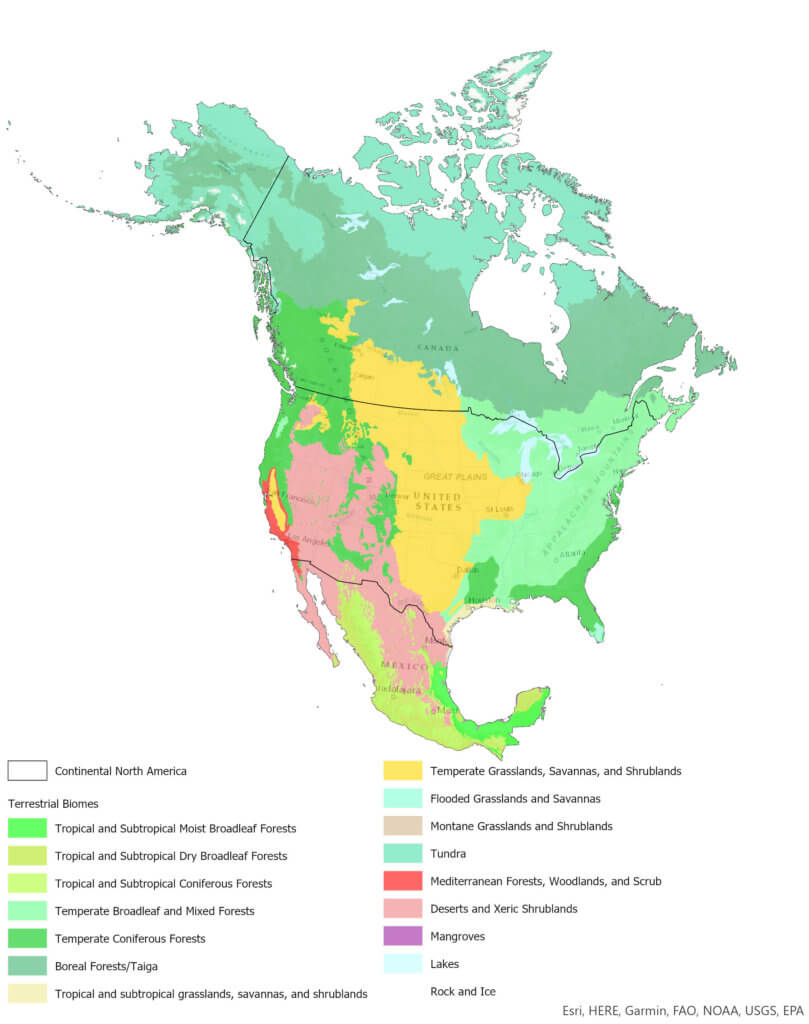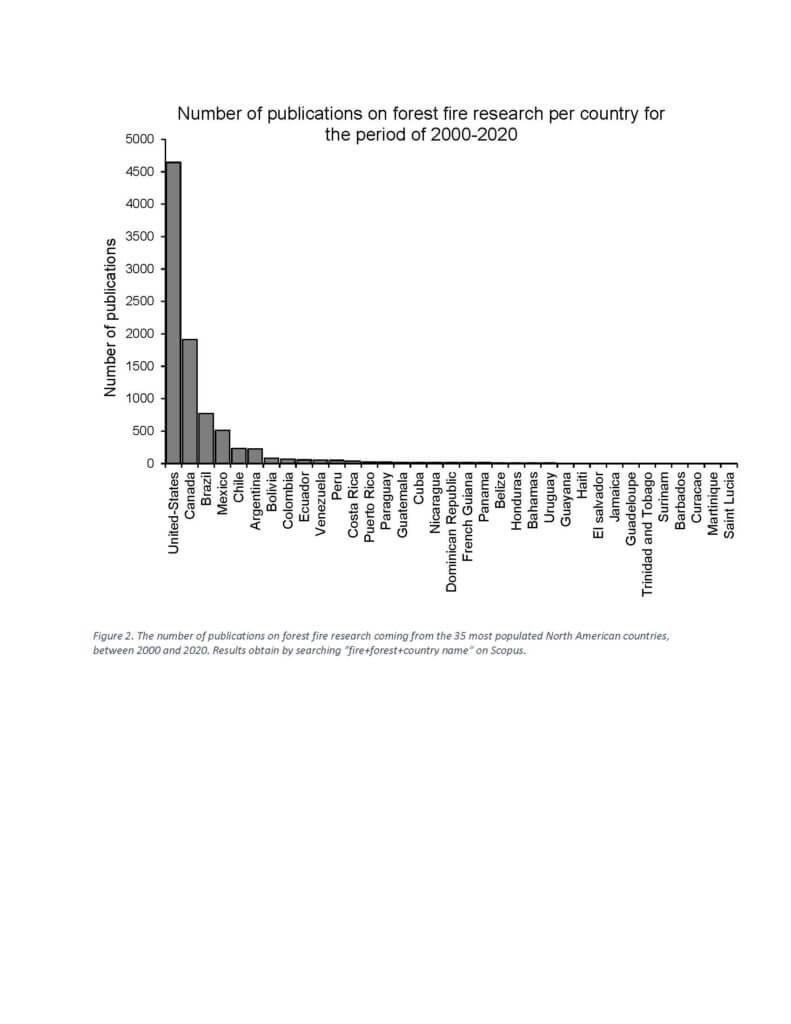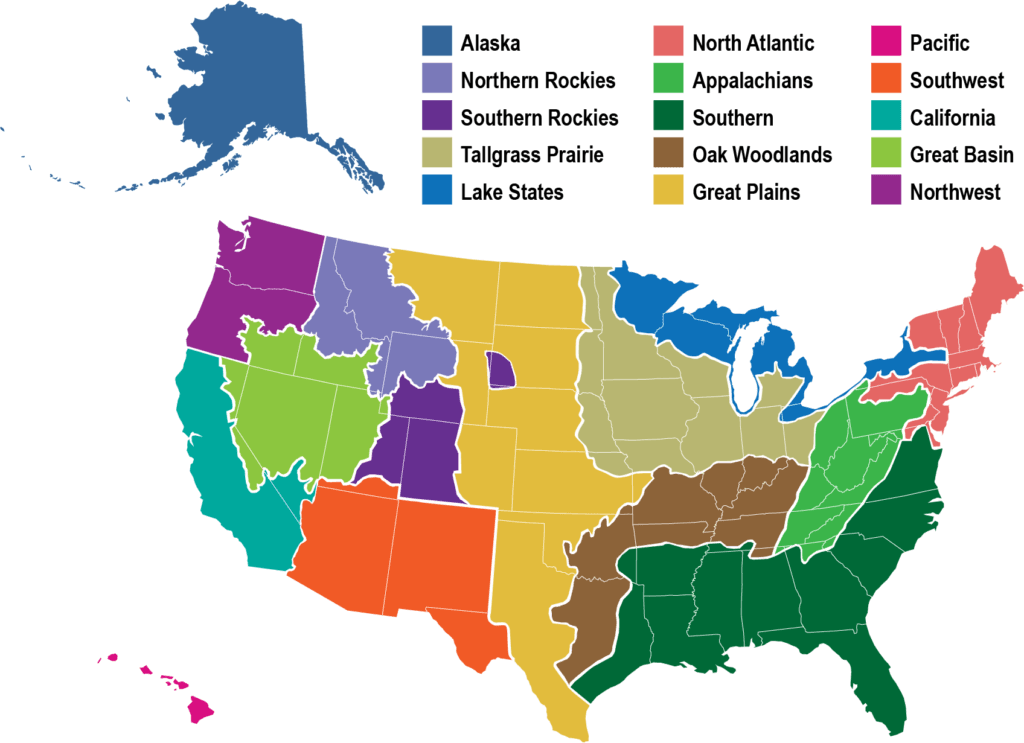North American Blueprint for Wildland Fire Science Collaboration
By Diego Pérez Salicrup, Stacy Sankey, Matt Jolly, Jonathan Boucher, Eric Toman, Christy Arseneau, Michael Norton
We need a comprehensive strategy to improve collaboration and capacity for wildland fire science in North America. Every year, wildfires burn across large areas of Continental North America. These fires recognize no political boundaries; some cross borders directly and require collaboration between countries for their suppression while resulting fire effects have social, economic and ecological consequences that are felt far from the location of individual wildfires. For example, smoke from California wildfires burning in September 2020 impacted air quality in Eastern Canada and Eastern United States. Despite the international distribution of biomes, sharing fire science across boundaries has proven difficult. (Figure 1).
The majority of land area in continental North America comprises three countries that offer contrasting fire management strategies and fire management histories. While Canada and the United States have comparable land areas, they have vastly different population densities: the United States has nearly 10 times more people per sq kilometer than Canada (Table 1). Population distribution is also different, with most Canadians living along their southern border, while the population in the US is more evenly distributed.
Not surprisingly, 50% of Canadian wildfires are ignited by lightning1 while humans account for about 84% of all wildfire ignitions in the United States2 . While forest areas in both countries are also comparable, forest land tenure is contrasting, with more forest area in private hands in the US. Mexico is much smaller, with almost one fifth of the area of its northern neighbours, but with almost twice the population density than the US (Table 1). Similarly, ignitions in Mexico are 90% associated with human activity. Forested areas in Mexico are also roughly one fifth of that of Canada and the US, yet because of Mexico’s proximity to the equator, it has a much higher diversity of species and ecosystems. Most forest land in Mexico is in the hands of rural communities who
also exercise a communal (named ejidos) approach to forest management, which has a large influence on how forests and fires are managed.
With all these diverse conditions and with increasing occurrence of large, severe wildfires, it is time to reflect on the experiences gained from the three countries and to assess common knowledge gaps in order to apply lessons learned to address emerging needs of contemporary fire management. The number of publications on fire research coming from North American countries is significant (Figure 2), but it is not diverse. Nor is the traditional approach of pursuing theoretical research questions and publishing findings in scientific journals sufficient. There is an increasingly urgent need to adapt, or even transform, fire management in North America and scientific publication is not enough to get the knowledge into the hands of wildland fire practitioners.
Ultimately, a different approach is needed, where research is aligned with current and future needs and results are actively and deliberately shared in a manner that supports decision making.
We propose developing a Blueprint for collaboration across borders to accomplish this.
NAFC- FMWG
The North American Forest Commission (NAFC) provides a policy and technical forum to discuss and address regional forest issues. The Fire Management Working Group (FMWG) of the NAFC was established in 1962 and has recently incorporated more science into its deliberations. It does not, however, currently have a continental direction for wildland fire science. By providing a Blueprint for wildland fire science collaboration, we expect to catalyze collaborative research across the three nations, and help identify what scientists and forest managers perceive as the largest voids of knowledge to improve forest fire management. The proposal to develop a North American (NA) Blueprint for Wildland Fire Science Collaboration was initiated at the NAFC-FMWG meeting in 2018. In 2019, the FMWG fully endorsed the proposed initiative and added it as an ongoing item on its work plan. As a first step, an ad-hoc group of representatives from government agencies and academia across Canada, the United States and Mexico have outlined a path forward towards a North American Blueprint.
The Blueprint
The development of a North American Blueprint for Wildland Fires Science Collaboration should foster at least three clear goals. First, it should identify common research themes and priorities as a basis for enhanced collaboration. Second, it will identify and offer proposed solutions to barriers to international research collaboration on wildland fire. Finally, it should help expand international networks and knowledge exchange forums.
This initiative will deliberately build from the success of the US Fire Exchange Network supported by the Joint Fire Science Program to redraw the map on fire science collaboration in North America (Figure 3). It is expected that the existing networks will be reinvigorated and expanded beyond traditional partners into a trans-boundary network of networks, as well as beyond the US borders. The intention is to not simply produce a document, but a living collaboration where the Blueprint is the roadmap.
Wildland fire management involves planning activities that go well beyond fire. The development of the North American Blueprint for Wildland Fire Science Collaboration will be purpose driven, based on shared priorities, and will privilege the co-creation of solutions by scientists and fire management practitioners.
Inspired by the Canadian Blueprint for Wildland Fire Science (2019-2020) (Sankey et al. 2019), initial discussions regarding a North American Blueprint for Wildland Fire Science collaboration identified three overarching themes of common interest to Canada, Mexico and the United States:
- Recognizing Indigenous Knowledge
- Community Resiliency
- Understanding Fire and Fire Management in a Changing World
We expect these themes to be validated and potentially expanded through workshops and surveys to help identify existing needs, consider similarities and differences across locations, and provide insight into the presence of existing networks that may facilitate information exchange between fire practitioners and researchers.
The process of developing a blueprint amongst countries as different as Canada, Mexico and the United States could offer lessons and guidance to serve the global wildland fire community. The approach will be interdisciplinary, in which specialists from social sciences such as economics, anthropology and sociology collaborate with plant ecologists, smoke experts, and fire modellers, and other disciplines to collaborate and engage with fire managers and landowners. This co-production approach with a diverse group of scientists and managers should lead to a better shared understanding of wildfire problems as well as the development of novel solutions to those problems.
The topic will be discussed at upcoming meetings of the Commission for Environmental Cooperation (CEC), Canada-US Forest Health and Innovation Summit, International Association of Wildland Fire (IAWF), and the Association for Fire Ecology (AFE). Reach out to [email protected] to stay informed.
ABOUT THE AUTHORS:
Diego Pérez Salicrup, Institute for Ecosystem Research and Sustainability, Universidad Nacional Autónoma de México (UNAM)
Stacy Sankey, Regional Policy Analyst, Northern Forestry Centre, Canadian Forest Service
Matt Jolly, Ecologist, Fire, Fuel, and Smoke Science Program, United States Forest Service, Rocky Mountain Research Station, Fire Sciences Laboratory
Jonathan Boucher, Researcher, Forests Fire, Laurentian Forestry Centre, Canadian Forest Service
Eric Toman, Professor, School of Environment and Natural Resources, The University of Ohio, Columbus, Ohio, USA
Christy Arseneau, Science Director, Atlantic Forestry Centre, Canadian Forest Service
Michael Norton, Director General, North Forestry Centre, Canadian Forest Service



